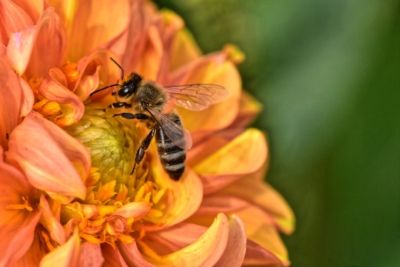Five Hot Topics for Corporate Conservation in 2021
If 2020 taught us anything, it was that plans can be derailed in an instant, priorities change overnight and what we consider to be pressing challenges one day can become low priority issues the next. In 2020 all sectors — business, government and NGO — saw their best laid plans unravel or become irrelevant in the global chaos of the pandemic.
As we look to 2021, it might be foolish to make predictions since the world is still an uncertain place. But five key issues taking center stage in 2021 give cause for modest hope and provide signals for businesses looking to advance biodiversity protection and ecosystem restoration in the new year.
The Super Year for Nature Reboot
2020 was meant to be the Super Year for Nature. It started in Davos in January, when the biodiversity crisis was brought to the forefront of the World Economic Forum. Throughout the year, a plethora of important meetings like IUCN World Congress and a UN General Assembly dedicated to biodiversity were slated to occur. 2020 would then culminate in October with the fifteenth meeting of the Conference of the Parties (COP15) to the Convention on Biological Diversity (CBD).
COP15 is now scheduled to take place in the second quarter of 2021 in Kunming, China, where signatories to the convention will adopt a Post-2020 Global Biodiversity Framework. The proposed vision of the Framework is that “by 2050, biodiversity is valued, conserved, restored and wisely used, maintaining ecosystem services, sustaining a healthy planet and delivering benefits essential for all people.”
While the role of business was largely omitted when the Aichi Biodiversity Targets (the precursor to the Post-2020 Framework) were adopted, the Post-2020 Framework, learning from the SDGs, “aims to galvanize urgent and transformative action by Governments and all of society, including indigenous peoples and local communities, civil society, and businesses, to achieve the outcomes it sets out in its vision, mission, goals and targets…”
The Post-2020 Framework currently proposes the following as the main expectations of business:
- That nature is valued by business in the form of ecosystem service valuation and financial disclosure
- That business supports the implementation of the framework with financial resources
- That business contributes to the “whole-of-society” approach considered an essential enabling condition for success
- As a footnote to the mission of the Framework, that biodiversity is mainstreamed across sectors of society and economy
Considering the failure to achieve any of the Aichi Biodiversity Targets, and the continued trends that have caused the World Economic Forum to highlight biodiversity loss as an “existential threat” in its annual Global Risks Report and highlight the failure of collective action to address it as a significant blind spot, the Post-2020 Framework must be emboldened with inspiring, actionable items for the private sector, indeed for all sectors.
Business engagement with the Post-2020 Framework is being pushed by the Business for Nature Coalition, of which WHC is a member. In 2020, the coalition secured commitments to its Call to Action when more than 600 companies with revenues of US$ 4.1 trillion pledged to call on governments to adopt policies now to reverse nature loss in this decade.
Underlining the emergence of nature as a business concern, the GreenBiz State of Business 2021 report acknowledges the increasing recognition of nature, and the risk the biodiversity crisis poses, optimistically stating that “once nature firmly takes root on the balance sheet, more companies likely will make investments that will help heal the natural ecosystem and preserve the world’s wealth.”
The Super Year reboot was supercharged at the One Planet Summit hosted by French President Emmanuel Macron in early January 2021. This summit saw world leaders embrace the biodiversity emergency like never before, resulting in a pledge to shift 30% of multilateral climate funding to biodiversity and Nature-based Solutions (NbS) for climate. The summit also saw more than 50 nations commit to the 30 by 30 initiative, a plan to create protected areas covering 30% of the planet by 2030.
Notably, the U.S. is the only UN-recognized country in the world (apart from the Holy See) that has not ratified the CBD. In 2021, pressure is on the Biden administration to work with the Senate to ratify the Convention so that the U.S. can play as significant a role in the Post-2020 Framework as it did in the Paris Accord
Redirecting Capital Flows
Performance Standard 6 of the Equator Principles has long been the main financial instrument for biodiversity protection. There is little evidence that the standard has achieved significant uplift for nature or slowed ecosystem loss; its adherence to the mitigation hierarchy has guided many companies toward the convenience of offsets without furthering other NbS practices. Recently established initiatives, however, bring the promise of more holistic financial tools in support of nature.
Following his launch of Terra Carta, an initiative to advance the concept of sustainable markets, the Prince of Wales also established the Natural Capital Investment Alliance, which aims to mobilize $10 billion toward natural capital investments. One of the partners in the Alliance is HSBC Pollination Climate Asset Management, which offers investment opportunities in nature-forward businesses like regenerative farms and sustainable fisheries, which promote biodiversity protection.
In addition, the Taskforce on Nature Financial Disclosure will deploy the learnings from the Taskforce for on Climate-Related Financial Disclosure to build a framework that will give corporations, and the financial institutions that support them, a clearer understanding of nature-related risk and impacts. This will inspire capital investments that finally fulfill the potential of Performance Standard 6.
Carbon Offsets: A Critical Examination
In recent years, NbS has emerged for the private sector as an effective tool for climate mitigation (reducing carbon) and adaptation (reducing impact of climate change). A Trillion Trees are being promised and every proposed approach to limit warming to 1.5o C contains a nature-based pathway, whether through wetland restoration, peatland conservation or soil health recovery.
For most companies, carbon offsetting and NbS have come together with a new focus on reforestation, afforestation and increased forest management —actions that can be beneficial for both climate and biodiversity. Trees are seen by the private sector as an attractive and accessible offset, easy to measure, easy to invest in and easy to promote.
While the years leading to 2020 saw the solidification of forests as a key player in carbon offsets, articles published by Bloomberg at the end of 2020 highlighted issues with accountability, additionality and reversibility, reporting that The Nature Conservancy sold carbon credits for forests not under threat of destruction and GreenTrees LLC sold carbon credits for existing forests planted with federal dollars on private lands. This attention to flaws in the governance of carbon offsetting poses a risk for the companies involved, but also creates an opportunity for NGOs, registries and companies to adopt universal standards.
Carbon offsetting through forest investments is a viable approach for corporate action, climate mitigation and biodiversity recovery but 2021 will likely see increased scrutiny. This will result in stronger guidance, more accountability, and the adoption of practices that embrace additionality in a significant way, promoting a shift towards The Oxford Offsetting Principles and other rigorous frameworks.
Environmental Justice: A Corporate Concern
In 2020, across the country and around the world, communities sought racial justice, equitable treatment and access to opportunity. As discourse on equity blossomed, climate justice and environmental justice emerged as significant challenges.
Studies from Italy and the U.S. conducted in the early days of the pandemic found that communities with greater air pollution had higher death rates from Covid-19. The New York Times reported that historic redlining (racially-based practices that restrict resource access) led to neighborhoods of color lacking urban tree canopies and disproportionately suffering from heat island impacts. These findings speak to decades of studies showing disparate health and wellness outcomes for differently resourced communities across the planet.
A growing call for marginalized communities to be included in environmental decision-making is emerging as plans are presented for a healthier planet, especially the 30 by 30 proposal. The IPBES and others have asked that indigenous voices are given equal representation and that community knowledge is valued on a par with academic research. In New Jersey, legislation passed to give communities greater say in the pollution burden they are willing to accept is considered the strongest environmental justice law in the nation.
WHC contributed to the conversation in 2020, publishing an examination of the ways in which urban industrial lands can contribute Nature-based Solutions to improve health outcomes. In 2021, with funding from the USFS Urban and Community Forestry Program and the Great Lakes Restoration Initiative, WHC will continue supporting ecological restoration on urban industrial lands. This work will result in a road map to encourage more companies to take a community-first approach with their nature investments, especially in communities overburdened by the impacts of industry.
Engagement with Nature
One of the silver linings of 2020 was increased interaction with, and awareness of, nature. When recreation, education, entertainment and retail spaces closed across the globe, nature remained open, providing myriad experiences to locked-down families. Backyard birdwatching, gardening, hiking and exploring the outdoors became simple pleasures and accessible distractions. Outdoor spaces offered safe places to alleviate isolation and depression. Outdoor classrooms provided safe educational opportunities. Time slowed and our awareness of nature quickened.
Across WHC’s community, innovative approaches to maintaining conservation programs on corporate lands with restricted access were developed. Employees, like those on the intrepid team at Bacardi Bottling in Jacksonville, Florida found they could continue their conservation efforts and include employees in safely distanced ways. As businesses reopen and employees return, outdoor activities are perfect for a safe and social re-entry.
As we build back to a new normal, it may be easy to lose sight of nature again, but it would be unwise to do so. Widespread appreciation for the outdoors will support better investments in nature, which are badly needed to achieve any of the goals we set for the planet. As we enter the UN Decade of Ecological Restoration, a ten-year effort to restore our planet, we need to harness the momentum gained, and lessons learned, in 2020, and use them to secure what Christine Lagarde, President of the European Central Bank, calls that most undervalued common good: nature.
Given that these topics speak to larger matters of global stewardship, transparency, equity and post-pandemic recovery, they are critical for everyone to consider. Companies are especially well-suited to champion these five issues as they integrate nature across operations and implement community-first conservation efforts.
In this second Super Year for Nature, these issues aren’t the only ones making strides. We’re also keeping an eye on:
- Continued evolution and understanding of the role of Nature-Based Solutions.
- Efforts to bring nature into supply chain greening efforts.
- Growing the number of corporate commitments to biodiversity.
NOTE: This post, first published on 1/19/2021, has been edited post-publication.


